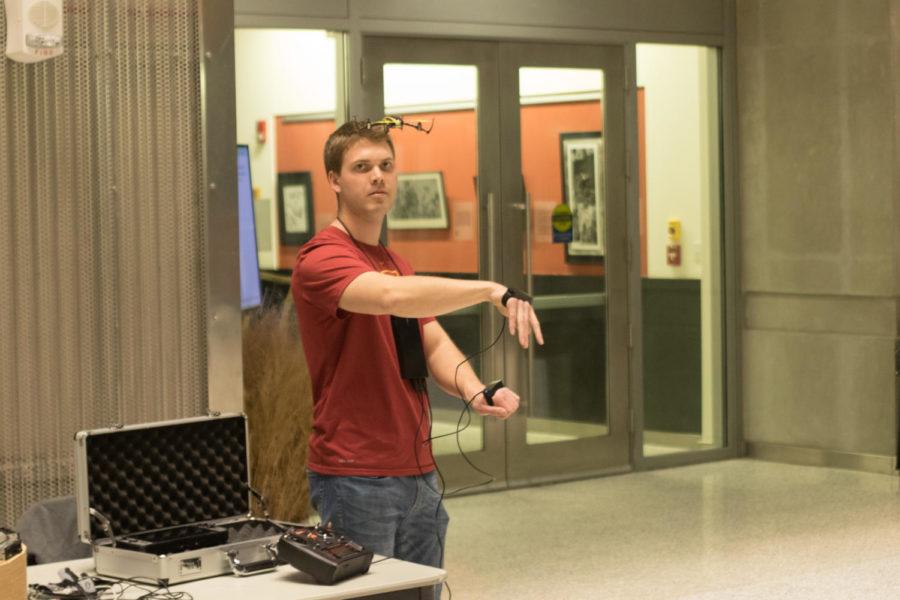Two students work together to create many advanced projects
January 30, 2018
The next “big thing” is usually unveiled by someone like Elon Musk, Tim Cook or Jeff Bezos, but the next big thing could just as easily be coming out of Iowa State.
Two students, Tim Lindquist and Jakub Hladik, work on projects together that go above and beyond what professors and job recruiters look for.
The two met before ISU Hackathon in 2016. Hladik was in the computer lab brainstorming ideas for the competition when he saw Lindquist working on a nearby computer. Hladik noticed Lindquist had an extremely organized workspace, something Hladik needed to work on. Hladik approached Lindquist and that year they won Hackathon with their Project Icarus.
Some projects between the two of them include Project Icarus, a motion controlled drone, a model for a single instruction processor and RAM, a Raspberry Pi 3 running RetroPie and a music box made with floppy disk drives.
Project Icarus
Project Icarus is a continuous project the duo has been working on. A drone is controlled by two straps you put over your hands. The left hand controls throttle and yaw, and the right hand controls pitch and roll. Sensors in the straps allow the user to control a drone, plane, boat or any other radio-controlled device with your hands.
The project initially started as a Hackathon project at Iowa State. It has since evolved past that.
After winning the 2016 Iowa State Innovation Pitch Competition, they created a second iteration of the product seen in the video.
Lindquist said they hope to make a third iteration, a wireless version, but in order to market something like that they would need funding and demand. The decision to move forward with this product depends on how much attention the video gets. The potential for a startup is very real. Lindquist and Hladik have a friend who would be able to market the idea if it picks up enough attention.
Lindquist said he sees application in military, beginner fliers and hobbyists for racing or general flying.
SUBLEQ: Single Instruction Processor
This project is what Lindquist and Hladik described as their “bread and butter.” This project pushed them past what they had learned in class to create something above and beyond what was expected.
SUBLEQ (SUbtract A from B and Branch to C if LEss than or EQual to zero) is a project the two worked on for EE 330, integrated electronics. The project went “above and beyond” as described by their professor for the class, Dr. Randy Geiger.
Lindquist and Hladik emphasized the point of this project was not to create a marketable product, but to better understand how processors work. They enjoy working on projects that are not necessarily practical, but expand on what they’ve learned in the classroom.
Geiger stated the two went above and beyond in the course not for a grade, but to further their understanding of the material.
Hladik and Lindquist “were being more aggressive than they had to be,” said Geiger.
Similar projects include Hladik’s Z80 processor, which Hladik said “by exploring this ‘dead’ architecture, I can explore how the current architectures evolved and why engineers designed them the way they are,” on his website.
Nintimdo RP
Nintimdo is Lindquist’s personal project. A video of its creation can be found on his YouTube channel, TimEE. The project was a summer project inspired by the Nintendo Switch, but made to play games from almost every console pre-2000, including the original Playstation, Dreamcast, Nintendo 64 and Atari.
The project cost Lindquist about $300 for the Raspberry Pi, touchscreen, controls from a Nintendo Wii classic controller and 3-D printed case.
Lindquist said he had more fun building it than he does playing it.
Flopperatus
Another Hackathon project, this time scoring third place overall, the Flopperatus uses floppy disk drives to play MIDI music files. MIDI files are similar to sheet music on a computer, they explain how to play a note’s tone, length, pitch, etc.
The device can play various songs such as the Mario theme song, “He’s a Pirate” from “Pirates of the Caribbean” and other songs from movies and video games.
Lindquist and Hladik both agree the biggest roadblock in this project was converting MIDI files to something the drives could use.
Two other students, Justin Wheeler and Josh Lendi, also helped work on this project.
Professors around campus see something in Lindquist and Hladik that they don’t necessarily see in every student.
Geiger, their professor for EE 330 who also works with Lindquist in his research, described both as outstanding and Lindquist as “one of my top students I’ve worked with over the past several years.”
Joseph Zambreno, professor in electrical and computer engineering, described Hladik as having an “excitement for technology and computer engineering and was definitely different than the typical student” and that he “was someone who would come to office hours not because he was struggling with any part of the course, but because he wanted to do more.”
Hladik, senior in computer engineering, is going to work for Rockwell Collins after college and is interested in going back to school to get a master’s degree or even doctorate after some time in the industry.
Currently Lindquist is in graduate school at Iowa State in computer and electrical engineering. Lindquist plans to go to school for as long as possible. More of his projects including a wireless web of sensors for the agriculture industry are available to look at on his website.
Geiger said Lindquist has potential “for moving to the top of the field.”
















